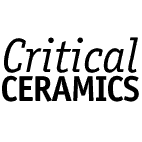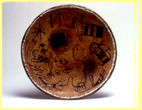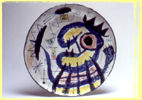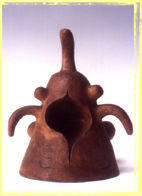Click to find out more...
Show your support by visiting our sponsor...



Photo: Michel Nguyen

Photo: Michel Nguyen
GIL McELROY
When you think of the work of Spanish born artist Joan Miró, it's likely you don't think of ceramics. As one of the great modernist artists of the twentieth century, it is his work on canvas — paintings — that come immediately to mind, trailed far behind, perhaps, by his large scale sculptural works, like the piece done in 1975 for the Los Angeles Museum of Art. Such thinking, however much we may deny it, is all very much a part of that tiresome yet endless debate about art versus craft that's become woven into the very fabric of ceramic discourse.
The fact that we think in such oppositional terms, however, is also very much part of historical choices made and decisions taken by curators, art historians, and even art dealers over the course of the twentieth century. As painting was deemed to occupy the apex of the modernist aesthetic pyramid, Miró's was of course given its rightful due and a place of prominence. Whatever else he did artistically would rate much further down the aesthetic slope, and ceramics would, in this scheme of things, be right down at the bottom of it all. Recently at The George R. Gardiner Museum of Ceramic Art (111 Queen’s Park, Toronto, Ontario, Canada; Telephone: 416-586-8080; Web: http://www.gardinermuseum.on.ca), the exhibition "Miró: Playing with Fire" (September 7, 2000 - January 7, 2001) attempted to change all of that with the first major North American showing of sixty ceramic works by Miró that span almost forty year of his prolific and lengthy career.
Although this exhibition carries Miró's name alone, none of the work shown here, gathered from private and museum collections in Europe and North America, has anything to do with an individual artistic endeavor. Each work is, in fact, part of a collaborative venture, most with Spanish ceramist Josep Llorens Artigas, a contemporary of Miró's with whom he initially began to work during World War II but whom he had known since art school days. A number of pieces represent Miró's later collaboration with Artigas' son Joan Gardy Artigas when the elder became too ill to continue their partnership, and there even are a handful of beautifully grotesque earthenware heads done with ceramist Hans Spinner (better known, perhaps, for his collaboration with British sculptor Anthony Caro) in 1981, only two years before Miró's death at age 90.
The collaborations between Artigas the elder and Miró had a shaky start. Artigas, who had by that time eliminated all decorative elements from his work, was concerned that, as a painter, Miró would approach ceramic forms as little more than surfaces to be decorated, as extensions, if you will, of the painterly canvas, neutral and blank. For his part, Miró, too, was aware of the need to adapt himself to the unique demands of ceramics, rather than imposing himself, and his painterly techniques on the medium. Their first works together done in 1944 comprised a series of tiles Artigas provided Miró to paint upon. The results were less than satisfactory, and most were destroyed. Miró then took pieces of broken fire clay from an abandoned kiln and decorated them with enamel. "Double-sided plaque" (1945), amongst the earliest of the Miró/Artigas works extant, typifies Miró's painterly approach to ceramics, while the earthenware work "Woman" (1945), a squat, conical sculpture with limb-like extensions and a large void inset from the side, hints at an approach more responsive to the nature of the ceramic medium.
By the mid-1950's, they had it down pat; Miró tuned his surface designs to Artigas' forms in a harmonious blend of the artistry of both men. The results were works like "Plate with colored figure" (1956), a stoneware piece dominated by a colorful central figure of red, yellow, blue and black, "Large vase" (1956) of red, yellow, and a blue shooting star decorating the stoneware shape, and "Plate"(1956), its stoneware surface swirling with small black figurative line drawings. The purity of form and dour, unadorned surfaces of Artigas' pre- Miró work had been radically transformed by color and design, while Miró's pre-Artigas painterly palette had encountered and responded to the transformative magic only possible in the fire of the kiln.
Miró and Artigas worked together producing plates, vases, sculptures and plaques until 1971 when the latter bowed out and his son, Joan, took up the collaborative slack. In gathering the works for this exhibition, curator Anne McPherson chose pieces from all of Miró's collaboration, but went so far as to include a selection of four of the elder Artigas solo works — a series of elegant stoneware vases — from the early 1970's. It was an inspired decision, giving us an opportunity to see the ceramist at his singular best, but as well to see a world minus Miró. As fine as these solo works are, in this case they are reminders that absence makes the heart grow fonder.

Photo: Michel Nguyen

Photo: Jaume Blassi